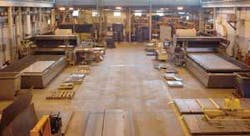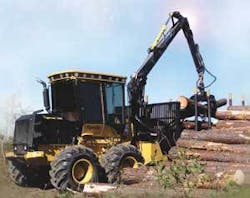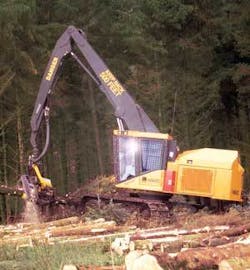Rick Neff
Two of the world’s largest laser cutting systems provide unattended high-flex cutting
By any measure, MacDonald Steel is one of North America’s largest fabricators - facility size (213,000 sq. ft.), production capabilities, and the oversized structures and components produced for a wide range of customers and industries. To further its “big” advantage, MacDonald has installed two long-bed Cincinnati CL-707 laser cutting centers with dual 8- x 20-ft. pallets and 10,000-ipm linear motor drive at its Cambridge, Ontario, plant.
MacDonald Steel replaced four standard-size lasers with two of the long-bed, high-speed Cincinnati CL-707s. Located in a dedicated bay with material storage of long sheets, the lasers primarily run sheets 96 in wide x 240 in or 200 in long. The greater size capability allows MacDonald to produce long parts in one pass, eliminating the need to weld together separate sections.
These laser cutters are the world’s largest with linear motor drive. MacDonald uses two of the massive, high-speed machines to achieve big output, big versatility, and big part size capability. The machines bring super-fast processing to thinner material, create precision holes to eliminate drilling, cut hundreds of intricate parts without reloading, and produce extra-long profile shapes with ±0.001 in. per axis accuracy and super edge quality.
MacDonald puts that versatility to work 24/7 cutting profiles for a wide range of industries, as well as two family members: Tigercat Industries and MacDonald Environmental. Tigercat (Paris, Ont.), a sister company, is a leading maker of premium logging machinery for rugged off-road terrain that must meet the extreme challenges that forestry equipment has to overcome. MacDonald Steel Environmental (Cambridge, Ont.), another division, makes industrial dust, fume, and air control systems with massive duct work and capture/filter structures.
MacDonald Steel specializes in fabricating oversize, heavy-duty parts for demanding applications, such as massive Tigercat timber harvesting machinery. To maximize part range and output, it selected two of the world’s largest high-speed lasers - Cincinnati CL-707s with dual 8 x 20 ft. pallets - for its Cambridge, Ontario, plant.
“We already had five Cincinnati lasers when we bought the first CL-707 in 2001, but they all had 72- x 144-in. beds,” says Joe Barroso, vice president. “We purchased the 8- x 20-ft. machine for the sheet sizes it could accommodate. It lets us do less handling of material, cut for a longer period of time, and run longer parts and profiles. Before, with the smaller machines, we had to switch plates more often. Now we can cut with fewer breaks between sheets. That was primarily the reason for buying the big-bed laser. “
While the 6- x 12-ft. lasers were the largest offered when MacDonald bought them, some large parts would exceed bed capacity, he notes. “Now we can make longer parts in one pass where we previously had to join two parts together,” says Barroso. “The longer bed let us eliminate the weld seams. We definitely take advantage of the bigger sheet size.”
The one-stop processing allowed MacDonald to meet the industry trend to shorter lead times, even on custom work. “That’s the biggest change in our business over the last few years,” says Barroso.
Tigercat, a subsidiary of Canada's MacDonald Steel, assembles its massive forestry and logging equipemnt from steel cut by lasers supplied by Cincinnati Inc.
Building on that advantage, MacDonald added a second 8- x 20-ft machine in mid-2004. The two machines are located side by side in a dedicated laser cutting bay along with material storage of long sheets. “Basically everything we run is 96 in. x 24 in. or 200 in. We no longer run smaller sheets unless we need a grade of material that’s not available in large sheets,” he explains.
Founded in 1957 as a custom steel fabricator, MacDonald Steel built a reputation for efficient production of large, high-strength components for demanding industries. Applications range from power distribution equipment and plastic injection molding machinery to large industrial shredders and stainless-steel tanks for beer and wine plants.
“The customer engineers a design and we figure out how best to build it,” says Barroso. “We have manufacturing engineers and product planning people that work out how to manufacture the pieces economically. Whatever the customer needs, we can provide it-laser cutting to building a complete machine. We can offer complete turnkey production, from machine and welding to the hydraulics, electricals, guarding, and assembly. When we’re done, it’s a running machine.” That do-it-all capability is creating more value-added opportunities for MacDonald as customers focus more on core business, he says.
MacDonald has long been a major supplier to heavy equipment and off-road vehicle manufacturers, producing machine chassis, booms, cabs, and roll-over structures. That experience led MacDonald to develop Tigercat Industries, which has grown into a leader in the logging equipment field with a comprehensive line of massive machines for felling, bunching, loading, and transporting logged trees.
The two long-bed lasers produce some large components for Tigercat, which has its own manufacturing facilities. In fact, Tigercat was assigned the smaller Cincinnati lasers when the MacDonald plant installed the CL-707s. “Basically, the bigger bed capacity let us replace four machines with two,” says Barroso.
The long-bed lasers also cut components for MacDonald Environmental, which shares the Cambridge facility. The lasers produce profiles used for filters and collectors, ducting, fan shrouds, bag houses-all the various elements needed for industrial environmental control systems. “Some structures are as big as a house, up to 30 ft. high,” notes Barroso.
Between custom work and family jobs, the MacDonald plant keeps the CL-707s running 24/7. The large bed capacity can allow extended periods of unattended processing. “We can start plates at the end of second shift,” he says. “When the day guys come in, the parts are cut. On Saturday noon, when our people typically go home for lunch, we load up the lasers, hit go, and the laser runs with nobody here. We’ve had excellent success with that.”
With the purchase of the unit, MacDonald Steel created a dedicated bay for laser cutting and material storage. “We reorganized and located the big-bed machines side by side with an aisle way between them,” says Barroso. “The operator can walk back and forth and watch both machines. All the material is stored beyond the machines going down the bay.”
Barroso was directly involved in the initial start-up, programming, and part nesting when MacDonald bought its first Cincinnati laser in 1990. At the time MacDonald used a plasma machine to cut profiles that could handle a maximum sheet of 48 in. by about 100 in. long, he says. “We’d shear plates, put them on the machine, plasma-cut the contours and holes, and then grind off the slag. It was a three-step process to get a part cut out, and the precision wasn’t there. The reason we bought the laser was to eliminate those processes, and the precision was unbelievable. People just couldn’t believe what was coming off the laser. Now we take it for granted. Back in 1990, that was truly amazing.”
Laser cutting technology keeps getting better and better, he says. “Power increases let us cut thicker materials and high-speed drives let us cut faster with even greater precision,” says Barroso.
Rick Neff is laser products manager, Cincinnati Incorporated, www.e-ci.com.


